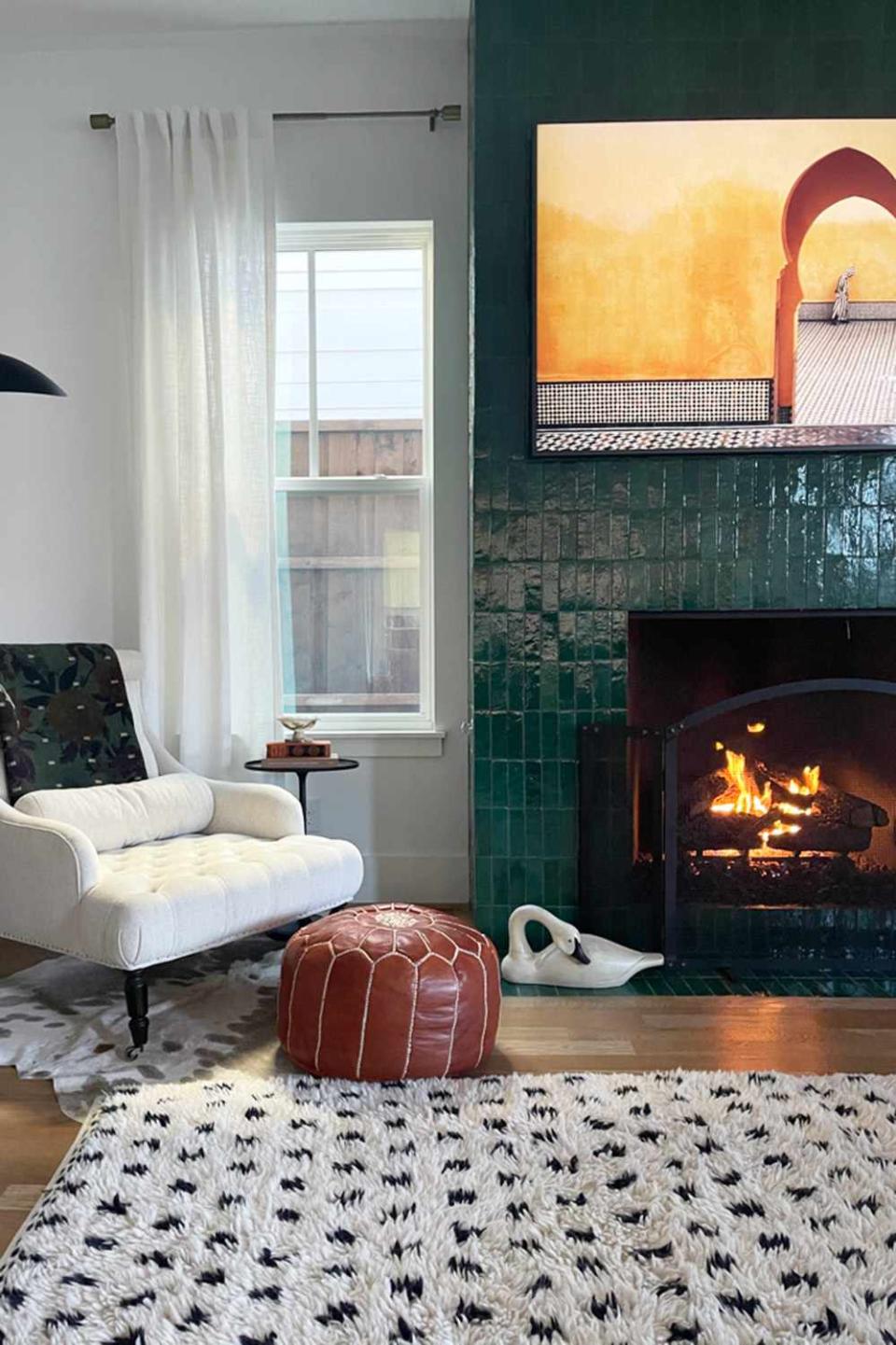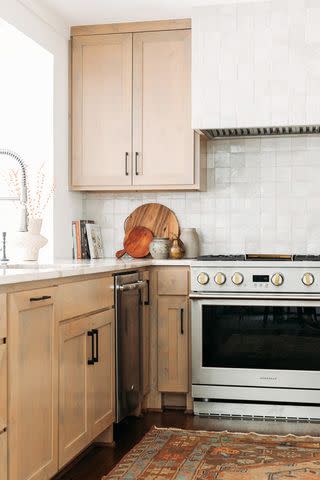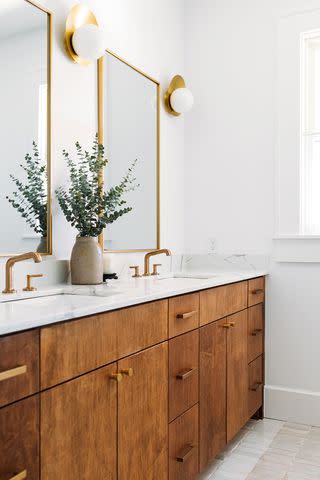What Is Zellige Tile? Design Ideas That Highlight Every Handcrafted Detail
Zellige tile is a centuries-old material that's having a modern-day moment.

Gilded Heights
If you’re looking for a tile to elevate your space, few compare to handcrafted zellige tiles. There’s nothing cookie-cutter about them. Instead, zellige tiles embrace imperfection to add character to a room. “When people see or pick up a piece of zellige, they can feel the story, the heritage, the craftsmanship, the connection to timeless tradition; it goes so far beyond decoration,” says Deborah Osburn, founder of Clé Tile.
Zellige tile is unmatched in bringing one-of-a-kind personality to a space. “Zellige imparts a distressed, lived-in look that adds character to any decor," Osburn says. "It will loosen up and modernize a traditional decor and impart a warm feel to even the most streamlined and modern of environments."
To get in on the design trend that's centuries in the making, we asked interior designers to deliver all the details on this character-rich tile, as well as design ideas for helping zellige tile live up to its potential in your home.
:

Kelly Christine Photo
What Is Zellige Tile?
“Zellige tiles have been around for hundreds of years,” says Aubrey Butcher, the interior designer behind Gilded Heights and co-owner of Riad Tile. “Each piece is a work of art, handcrafted by artisans who have learned their trade from ancestors before them.” It’s this originality that Butcher credits with zellige's current popularity. “There aren’t many materials that are as versatile and original as zellige,” she says.
In order for a tile to be considered authentic zellige, Osburn explains it has to be made in Morocco. There’s an art to the hand-cutting and chiseling of the tiles which has been passed down through generations. “Every tile is hand-molded, hand-cut, and hand-glazed, which means no two zellige tiles are exactly alike,” she says.
Osburn explains that authentic zellige from Morocco uses clay sourced from Fez, a city in the northeast part of the country. “[The clay] is molded into blocks, cured in the sun, then hand-cut into tiles before it is hand-glazed and kiln fired in ancient bee-hive kilns, fueled by olive pits and branches.”
This entire process and attention to the generational wisdom that comes with the trade is what gives zellige its hand-hewn and “perfectly imperfect” appearance, she says. You can spot authentic zellige tiles by paying attention to these imperfections. “The most defining characteristic of authentic Moroccan zellige are its beautiful flaws, irregularities, and variation,” Osburn explains.
:

Kelly Christine Photo
5 Things to Consider Before Choosing Zellige Tile
1. Tile Resiliency
Because of its detailed appearance and handmade quality, it’s easy to think zellige should be admired from afar, but Butcher says that couldn’t be farther from the truth. “Zellige is not as fragile of a material as it appears once it’s been delivered,” she says. “Each piece is fired in a kiln multiple times, making it very strong and resistant to heat.” It’s also easy to clean so it's ideal for use in places like kitchens and bathrooms, as it doesn’t show soap scum like other tiles might. To clean the tiles, Osburn recommends a mild, pH-neutral soap, but suggests testing it in a small area before applying it at large.
:
2. Color and Glaze Selection
When it comes to color selection, Osburn points to white options like Clé Tile’s Moroccan Sea Salt and Weathered White as customer favorites, though their collection of Neo-Neutrals, which encompasses pinks, beiges, platinum whites, and gold, is growing in popularity. “We also are finding that deeper colors such as green and red are increasingly popular," she says. "The rich glossiness of the glaze only serves to play up the zellige’s characteristic texture."
When working with colored zellige tiles, Butcher finds the natural variation in the glazing to be perfectly striking and impossible to recreate with porcelain or ceramic options. “Natural colorways pair perfectly with marble in bathrooms and kitchens, creating a timeless, tonal space,” says Butcher. “For a more striking look, using color is always a fun choice.”
If you’re deciding between glazed and unglazed zellige, consider whether you want a bold or subtle look. A glossed zellige works to reflect light, lending a more glamorous quality that, according to Osburn, accentuates the handcrafted quality of the tiles.
3. Design Ideas
When it comes to zellige tile design ideas, the possibilities are endless. “This is especially apparent in Morocco, where everything from park benches to the exteriors of buildings to interior stairs is covered in zellige,” says Butcher. The designer is a fan of zellige for a kitchen backsplash, but her favorite application might just be a project that hits closer to home. “We also renovated our fireplace a few years ago and took a dark green zellige tile floor to ceiling, and it’s become a favorite part of our home.”
Some of the more popular applications are baths and showers, bar areas, and accent walls. However, Osburn is quick to advise going a more unexpected route if you’re so inclined. For her, it’s the unique uses like ceilings and exterior garden walls that truly highlight the artistry in the material and provide a light-reflecting dimension.
While the design possibilities are seemingly endless, there are a few places where Osburn and Butcher say zellige tile could be ill-advised. Avoid freeze-thaw environments and be aware of staircase applications as zellige tile can be a more slippery surface than wood or other materials.
4. Grout Selection
According to Osburn, traditional applications of zellige tile don’t use grout at all, instead calling on a butt joint. While this process has stood the test of time, she recommends customers opt for grout and a slightly larger joint of 1/16. “Because each piece of zellige is handmade, there will be imperfections along the edges from time to time,” explains Butcher. “We usually recommend a tonal grout choice, as this complements it best.” A contrasting grout could draw attention to the otherwise unique imperfections in a way that isn’t as flattering.
:
5. Installation Considerations
Zellige tile requires professional installers, ideally those who have experience installing handcrafted tiles. “Installers who have no experience with zellige are often confused by the ‘perfect imperfection’ of authentic zellige and uncertain of how to install tile in a way that takes the most advantage of zellige’s inherent textural, size, and color variation,” Osburn says. Blending the tiles, in both color and size, is paramount. Clients should be present throughout the installation process so they can work with the installer to ensure they are pleased with the overall look and feel. All tiles should be taken from the box and laid out on the floor. That way, you and the installer can then begin laying them out in a blended fashion, exactly how you want them to appear. Be prepared to shuffle and reshuffle the tiles until you find the perfect layout.

